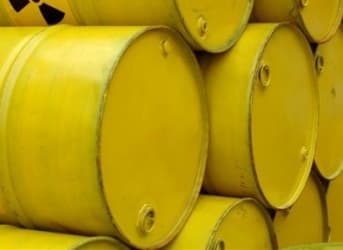Tokyo Electric Power Company (TEPCO), the embattled owner of Japan’s crippled nuclear reactors, has said it is running out of space to store water contaminated with radioactive materials and is proposing to treat the water and dump it in the Pacific Ocean.
Up until now, TEPCO has been storing radioactive water in giant storage tanks on the site of its Fukushima reactor. But groundwater continually flowing into the reactor site becomes contaminated as it does so. Containing and storing an ever-increasing volume of contaminated water is a bit like running on a treadmill – new groundwater becomes contaminated just as TEPCO succeeds in removing previously contaminated water. Meanwhile, the storage tanks multiply around the reactor complex.
In June, TEPCO began construction on what it hoped would be a more permanent solution – an “ice wall.” This is how it is supposed to work: TEPCO would insert 1,500 pipes into the ground around the damaged reactors. It would then flow liquid through the pipes at -30 degrees Celsius, which would freeze the soil. That way, as groundwater rushed downhill towards the complex, the ice wall would block the water from flowing underneath the plant.
Separately, TEPCO is trying to freeze the contaminated water that has leaked directly from the reactor buildings into underground trenches. In total, a staggering 11,000 metric tons of water containing substances like uranium and plutonium has accumulated. TEPCO has thus far failed to freeze the contaminated water, and had to resort to dumping ice onto the site in an effort to freeze the area.
Now the company has admitted that it can’t keep up. So it wants approval from the Nuclear Regulatory Authority to pump out the water, treat it, and begin dumping it into the Pacific.
“We know we have to get an agreement from the relevant government authorities, the prefecture and local fishing unions,” a TEPCO spokesman said recently.
But pushback from the public could present a problem. “We would never consider dumping the water into the ocean unless we received the consent of local residents,” the TEPCO official told Asahi Shimbun. “The water close to the plant buildings is already contaminated. Fishermen are sure to raise objections to the plan, so it will be difficult to gain their understanding.”
The Nuclear Regulatory Authority (NRA) has been critical of the company for not solely focusing on the contaminated trench water – which it says should be the highest priority – but spending resources on issues with lower priority.
“The biggest risk is the trench water. Until that matter is addressed, it will be difficult to proceed with other decommissioning work,” Shunichi Tanaka, NRA chairman said at a news conference, according to the Wall Street Journal. “It appears that they are getting off track.”
Controlling, treating, storing, and disposing of contaminated water is the most critical task in the near-term. Even if that can be resolved, the next step will actually decommissioning the destroyed reactors -- a colossal engineering challenge expected to take 40 years and cost over $15 billion. Nothing like it has ever been done before; indeed, the task is so unprecedented, it will require robotics that haven’t been invented yet.
ADVERTISEMENT
But first, TEPCO has to find a place for its toxic water.
By Nick Cunningham of Oilprice.com



















tragic is too soft to slight a word. there are no words.
Here's how I did it:
First of all I put all the radioactivity on the same footing as of being of Uranium only.
The Pacific contains about 2.2 x 10^11 Ci(Curie) of natural radioactivity.
http://www.physics.isu.edu/radinf/natural.htm
As far as "one Curie is roughly the activity of 1 gram of the radium isotope 226Ra"
http://en.wikipedia.org/wiki/Curie
and "Radium is three million times as radioactive as the same mass of uranium"
http://en.wikipedia.org/wiki/Radium#Radioactivity
this means that Pacific Ocean is as radioactive as if it contained
2.2x10^11 x 3x10^6 = 6.6x10^17 grams of Uranium. Or 6.6x1011 tons of Uranium.
660 billions tons in Pacific.
This is the natural, always presented radioactivity.
Now, how much of the Uranium fuel is there in Fukushima?
Let's say 1 ton. And because this is an isotope that is tenfold as radioactive as the "usual" Uranium let's sum it up to 10 tons.
All this means that Fukushima would add 10 tons to the already existing natural 660 billions tons in Pacific.
Very dangerous is it?
...................................
And another thing:
Assume we have a sphere of contaminated water with 1 meter radius.
When this water propagates to the clean water it forms a sphere with 2 meter radius. The latter has a volume 23=8 larger than the initial sphere hence the concentration of contamination decreases eight times.
One additional meter of propagation means 33=27 times less concentration of contamination.
This is Bio Terrorism
They have no rights to the Pacific
This is a G 20 Immediate Issue
Two years late ~
Im not sure what kind of Mental Issues
They are experiencing
This would make sense to a four year old
If we do not address this ,
as the Pacific meets the Arctic
We are denying our Progeny
The promise of Tomorrow